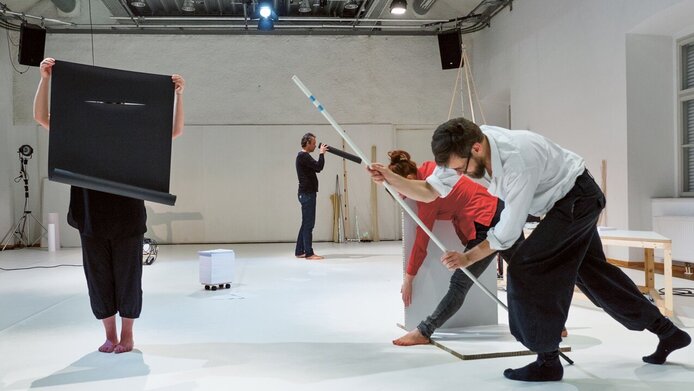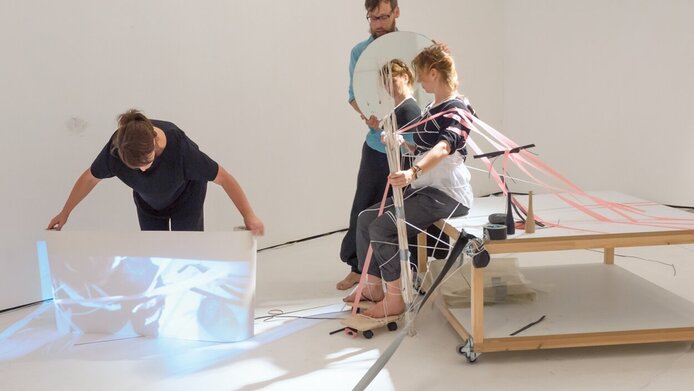Noting down the moment

“How does language feel when you roll it around your tongue?” is projected onto a white wall by a beamer while a rod repeatedly and swiftly crosses the light beam, reflecting and blocking – but not slowing down – the letters on their way from the light source to the wall. Welcome to the “method lab” of Nikolaus Gansterer and his team, an artistic test rig for gaining practical knowledge. Gauging the world in order to know it. That is a deeply scientific approach. It is also a need felt by artists. “Science and art”, emphasises Nikolaus Gansterer, “are very closely linked”. Just as science exists in all its different disciplines, art has its disciplines too, and since Antiquity they have been spiritual siblings. “Artistic research is about understanding the world, uncovering its underpinnings”, explains Gansterer in the interview with scilog. This statement defines the common foundation on which his work that combines art and research is based.
Thinking, feeling, knowing
Choreo-Graphic Figures: Deviations from the Line is the title of the project undertaken by the artist Nikolaus Gansterer together with dancer Mariella Greil, art-writer Emma Cocker and various guests over the past three years with the support of the Austrian Science Fund FWF in the context of its PEEK programme. “Deviations occurred simply because the project was set up as an encounter between three different disciplines.” It served as a meeting-ground, an investigative field lying between the poles of choreography, writing and drawing, i.e. genuinely artistic means, which explore the forms of thinking-feeling-knowing generated by a collaborative practice. “Deviations”, Gansterer adds, “are meant to be seen as a positive notion. They make it possible for us to pose questions.” Deviations as an incentive, as an encouragement to discover new worlds. For their investigations the artistic research team used the “method lab”, a space in which writing, choreo-graphy (Gansterer insists on the dividing hyphen here to underline that no prescribed choreography is involved but rather one that arises ad hoc and in situ out of the experiment itself) plus drawing are executed, experienced, perceived and recorded simultaneously.
Being in the world
“What we have uncovered is a system that looks into these movements”, is how Gansterer describes the process and goes on to add: “It is about forms, traces and figures of being in the world.” Sometimes, the artist recounts, these choreo-graphic figures emerged – and sometimes they did not. This cannot be controlled rigorously. After three years of intense work, observations and documentation together with partners from philosophy, theatre and dance studies, the system is now finally ready to be publicly communicated. The research results have just been released in the volume Choreo-graphic Figures: Deviations from the Line published by de Gruyter. The publication includes numerous images and articles by the project team as well as diagrammatic drawings by Gansterer and successfully conveys both the uncovering of forms of thinking-feeling-knowing and the laboratory and workshop character of the project.
It would be tempting, notes the principal investigator, to continue the work by expanding the circle of partners, for instance by including experimental physicists in co-operation with CERN. Because “it is very much about micro-gestures, micro-situations, it is about the small and the smallest”, Gansterer explains. “In the labs we always used our own bodies as a resource.” This means there were no sensors or technical recordings, but the participants trusted their own perception skills, which were heightened in the process. “You notice a wrinkle on the face of your partner that appears only for a fraction of a second”, is how Nikolaus Gansterer describes this “fine-tuning” of one’s body and one’s senses. “The awareness of the space increased so much that I was able to perceive what happened behind me while I was crossing the room.”
Every click a notation
A delicate situation, particularly since one has to find and develop a type of notation that describes things “without ruining them” in the moment they emerge. “During work at the lab something atmospheric develops which one may destroy merely by talking”, says Gansterer, “or by movements, finger-pointing. This challenge kept us occupied until we finally found markers in a simple click which enabled us to record something on video without destroying it.” – Many things still need to be noted down. This was just the first step.
Personal details Nikolaus Gansterer is the co-founder of the Institute of Trans-Acoustic Research and of the sound collective The Vegetable Orchestra. He teaches, inter alia, at the Institute of Transmedia Art at the Vienna University of Applied Arts and has been a visiting professor at the Center Research Focus Vienna since 2016.
Publication
Nikolaus Gansterer, Emma Cocker, Mariella Greil (Eds.): CHOREO-GRAPHIC FIGURES: DEVIATIONS FROM THE LINE, “Edition Angewandte” series, Verlag Walter de Gruyter, Berlin/Boston, 2017. ISBN 978-3-11-054660-6
Project website: http://www.choreo-graphic-figures.net/







